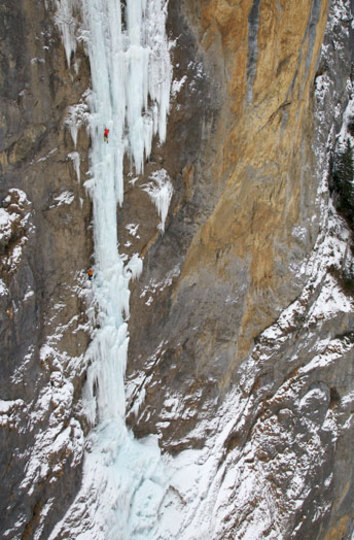
January 3, 2008: Robert Jasper and Bernd Rathmayr on the first integral ascent of B.A.S.E. (WI6+, 11 pitches, 450m), Lauterbrunnen Valley, Bernese Oberland. The next day they established Almendudler (M9+/10-, 350m), and the day after that they climbed Crack Baby (WI6). In three days they had climbed more than 1000 meters, much of it on new terrain.
[Photo] Klaus Fengler
Robert Jasper of Germany and Bernd Rathmayr of Switzerland took advantage of ideal ice conditions and made the first integral ascent of B.A.S.E. (WI6+), the first ascent of Almendudler (M9+/10-) and an ascent of the ultra-classic Crack Baby (WI6) in the Bernese Oberland, Switzerland, over three days at the beginning of January, 2008.
On January 2 Jasper and Rathmayr planned to redpoint the Almendudler (350m), a mixed route attempted in 2003, in the Almenalp Valley, when they heard that the previously unclimbed Buchenbachfall (450m), in the Lauterbrunnen Valley, had just received its long-awaited first ascent in parts by locals Ralph Jorg and Peter von Kaenel over two days, December 29 and 31, 2007 (reported in the January 4, 2008 NewsWire).
Buchenbachfall, renamed B.A.S.E. by Jorg and von Kanel because of the dozens of base jumpers who dropped down over their heads, rarely, if ever comes into condition, so Jasper and Rathmayr decided to try their luck and made the first integral ascent on January 3.
Early in the morning on January 3 Jasper and Rathmayr had quickly climbed the first three of the eleven pitches by simulclimbing with headlamps until steep and unstable ice forced them to start belaying. The two climbers swapped leads after each pitch and enjoyed better ice as they gained height on the last eight pitches, including two crux pitches graded WI6+. They completed the onsight in seven-and-a-half hours.
Despite the strong Fohn, warm wind from the south that normally melts icefalls, the two climbers and photographer Klaus Fengler encountered the next morning, the three headed to the base of the icefall to assess conditions.
“Only when standing right below the icefall can you see if it’s safe to climb or if it’s better to grab a couple of beers in the village below,” Jasper reported. “Cold air in the Kandersteg valley had managed to withstand the Fohn and ice conditions were perfect. Nevertheless we had to climb fast because of the length of the route. Thankfully I knew the hardest sections from previous attempts, and with such tired arms the M9+/10- redpoint ascent would otherwise have been out of the question.”
Everything went perfectly and the first ascent was completed in seven hours on January 4. Still not content, the duo set out on January 5 to climb the classic Crack Baby.
“Crack Baby isn’t just a great classic for me, it is also a journey back in time to 1997 when we had to fight hard for the route’s third ascent,” Jasper reported. “At the time it was one of the hardest and longest ice climbs, a really impressive testpiece.”
Xavier Bongard and Michael Gruber first cracked the route in winter 1993, and the icefall was probably one of the first to be graded WI6. This was the absolute limit of what was possible at the time, and that is why this classic is still considered one of the best icefalls in Europe.
This season the small cable car that climbers use as transport was severely damaged so Jasper and Rathmayr ascended the thousand meters from the valley to the base of the route on foot and backcountry skis. Although they felt the effort of the last two days, they were still highly motivated and reached the top after four-and-a-half hours of climbing, thus completing three solid routes and more than a kilometer of vertical climbing in three days.